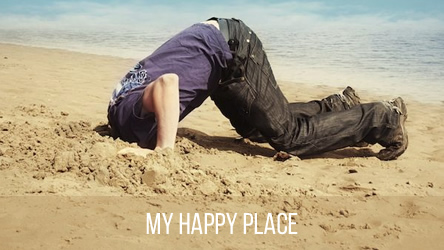In my role as a meditation teacher, I’m privy to many assumptions about the practice. Such assumptions are most frequently expressed when I’m invited into a workplace, where, not surprisingly, I’m bound to share the room with a number of skeptics. Typically, such people have not explored meditation in much depth, and tend to view it through lenses coloured by stereotypes. Their comments often reflect a slightly jokey, and slightly derogatory or dismissive attitude. Sometimes they’ll walk into the room with their arms apart — index fingers and thumbs pressed together — looking about for the cushions (in expectation of having to sit cross-legged on the floor). Perhaps this shouldn’t be surprising given the ridiculous number of stock images you can find online, and which seem to suggest that this (see image below) is just what meditation is about.
 Alternatively, someone will chant “Om”, or cheerfully announce that they are off to find their Happy Place!
Alternatively, someone will chant “Om”, or cheerfully announce that they are off to find their Happy Place!
It’s interesting that these three things (mudras, chanting, and the notion of a happy place) should go together. There does seem to be something slightly silly — or naive — in the expectation that arranging your body in a certain posture, or repeatedly chanting a word or phrase, should help you to get through your day better. So, why does the notion of a happy pace get lumped in with such ideas?
Perhaps the skeptics are onto something? Perhaps they intuitively recognise that you need to take action and face up to difficulties in order to resolve them, and that the temporary respite offered by some meditation practices (or more accurately, the way in which they’re practiced) is not always healthy.
Indeed, for some people meditation is a vehicle for transporting oneself to a happy, or happier place. And what could be wrong with that, you might ask. Isn’t that why people meditate? To find a place free of stress, anxiety and worry?
Well yes; I don’t think anyone would meditate if it didn’t somehow lead to positive emotional states. But how you go about accessing these states can have a significant impact on how fully you benefit from the practice.
The fact is, we live in an age, and a culture, in which instant gratification, distraction and avoidance are the de facto responses and means of self-soothing. We watch TV, we eat, we drink, we drug ourselves, and we browse the net and check our mobile phones incessantly. We run away from and repress our boredom, our worry and even our craving for love and acceptance — as though such feelings are somehow threatening, dangerous or just plain wrong.
It shouldn’t be surprising then, that these same culturally ingrained habits are reflected in the ways in which we mediate, and the meditation techniques we’re drawn to. The idea of a happy place reflects these tendencies, especially when it’s used as a way to escape the harsher realities of life.
This is not to say that an escape can’t be useful, nor that it isn’t necessary at times; but in many students, I see a slightly unhealthy reluctance to sit with thoughts, emotions and pain. It’s as though they are addicted to the notion of a happy pace. They use it as a way to dissociate and detach from the problems in their lives, rather than as a way to address and learn from these problems. This, I believe, isn’t the most mature or effective way to address the inevitable stresses of life.
Indeed, a happy place is where children go when they’ve been abused or suffered some trauma which they can’t make sense of. They escape into a world of fantasy because they don’t have the capacity to understand what happened, and because it’s too frightening to contemplate or comprehend. Such patterns may take years, or even decades to overcome. But if healing is to occur, a journey must be made; from child-like escapism to mature exploration. You must turn toward — rather than away from — the stresses and discomforts life throws your way.
So how can you tell whether you are meditating — or accessing a happy place — in a healthy way? Many meditation practices seem to encourage a greater degree of detachment (from thoughts and emotions) than would seem necessary, or psychologically sound. As mentioned above, escapism, or withdrawing from the pressures of the real world into a safer fantasy world, is pervasive in our culture. It comes in many forms, some rather subtle.
When we practice escapism, we avoid “spending time” with ourselves. We might use meditation as a way to block out our thoughts and feelings rather than as an opportunity to engage in healthy introspection. In this respect, escapism is the opposite of mindfulness.
For a happy place to be healthy, it must be accessed from a place of emotional security, and not used as a means to escape reality. If you are trying to get rid of “negative” emotions, and you do this reflexively, you are practicing escapism. On the other hand, if you use fantasy as a way of taking an occasional break from highly stressful situations then that is fine. And if, in your happy place, you access creative states of mind in which new insights and perspectives into your circumstances arise, so much the better.
It may be worthwhile then, to ask whether you repeatedly choose to distract yourself from certain thoughts, feelings or situations. Is your happy place a means of avoiding the inevitable stresses of life?
Or do you return from your happy place with new skills: better ways of dealing with the situation you temporarily escaped from? Have your views changed about the people you may have been having trouble with? Do you feel more capable of dealing with the situation you left? Do you approach stressful situations with less anxiety and dread, with greater confidence? Do you return from your happy place with fresh insights into the problems you were facing?
And over time, do you develop a greater capacity to face — and to be interested in exploring — all aspects of your life. Interestingly, a genuine “happy place” is the natural result of working through difficult thoughts and feelings, rather than retreating from them.
Remember, inner conflicts don’t vanish just because you divert your attention away from them. Nor are such inner conflicts resolved by deeply tranquil or highly aware meditative experiences. Such experiences can help, but they aren’t a real solution.
Thoughts and emotions can’t be stopped. Distracting yourself from them can only provide the most temporary relief. They will be waiting when you return from your happy place. The question then, is not how to avoid them, but how to relate to them, in skillful and psychologically sound ways.


Thank you for this insightful reminder about the difference between escapism and engagement. It’s nice to know too, that on some occasions escapism is OK, e.g. maybe when at the dentist?!